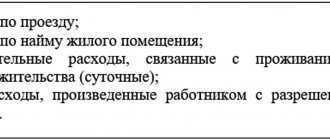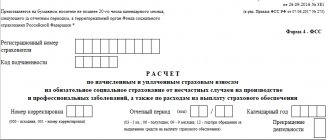The advance travel report in 2021 remains one of the few mandatory travel documents. It is one of the strict reporting documents, and the procedure for filling it out is clearly regulated by the current legislation of the Russian Federation. And since this document is an element of accounting, financial and tax reporting and may be subject to inspection by regulatory authorities, a “free-for-all” approach to filling it out is unacceptable.
- 2 How to fill out an advance report for a business trip
2.1 Photo gallery: sample of filling out an advance report
- 4.1 Features of confirming expenses for a business trip abroad
- 5.1 Photo gallery: posting options for travel expenses
5.2.1 Postings for travel expenses from the example (table)
What is an advance travel report?
An advance report for a business trip is an accounting document that each employee fills out upon returning from a business trip, reflecting all reimbursable expenses incurred in connection with the business trip, and attaches documents confirming these expenses.
This is what an advance report with supporting documents looks like
For the accounting department of the employing company, this document performs two functions at once:
- acts as confirmation of expenses when issuing an advance before the employee leaves on a business trip (and issuing an advance to him is the employer’s obligation, provided for by law);
- serves as the basis for transferring to the employee the funds due to him in the form of compensation for his expenses.
The advance report is also of key importance from the point of view of tax accounting:
- according to Art. 252 and paragraph 1 of Art. 264 of the Tax Code (TC) of the Russian Federation, travel expenses are other expenses in connection with production and sales;
- in accordance with Art. 313 and 314 of the Tax Code of the Russian Federation, these expenses must be confirmed by primary accounting documents, which include the advance report;
- To record expenses according to accounting documentation, you need the date on which these expenses were incurred; according to the law, such a date in relation to business trip expenses is recognized as an advance report.
For the purposes of this chapter, the taxpayer reduces the income received by the amount of expenses incurred <…>. Expenses are recognized as justified and documented expenses <…> made (incurred) by the taxpayer. Justified expenses mean economically justified expenses, the assessment of which is expressed in monetary form. Documented expenses mean expenses supported by documents drawn up in accordance with the legislation of the Russian Federation<…>. Any expenses are recognized as expenses, provided that they are incurred to carry out activities aimed at generating income.
Art. 252 of the Tax Code of the Russian Federation
Until 2015, the package of mandatory travel documents was quite thick. It included, in particular, a travel certificate and a work assignment form with a report on its completion. By 2021, as a result of recent changes in legislation, only an advance report and a business trip order remained mandatory for everyone by law. All others have become optional. If their use is still practiced in the organization and this is reflected in the local act regulating business trips of employees (most often this is a provision on business trips in the organization, but other options are allowed, for example, a set of individual orders), they still need to be issued. And if not, then they are not needed. But in the case of an expense report, the obligation to prepare it is not even discussed.
How to fill out an advance report for a business trip
The standard advance report form in form AO-1 (download form) contains a front and back side.
The following information is indicated on the front:
- Full name of the reporting person (sent worker);
- his personnel number (as a rule, this item is filled out by an accountant);
- job title;
- data from the primary document (most often a cash order if the money was issued in cash, or data from a document confirming the transfer of funds to a corporate card), confirming the issuance of an advance. A number of companies practice partial issuance of an advance, so to speak, in kind, when the company, instead of giving an employee, for example, money for travel, purchases a ticket for him. In this case, the ticket is handed to the employee before the trip, and in the advance report it is reflected in the number of documents confirming receipt of the advance (most often this section is filled out by an accountant);
- information about the balance of the previous advance, if applicable (can be completed by an accountant).
The reverse side of the form is dedicated to the actual expenses. Here you need to specify sequentially:
- the date the expense was incurred;
- serial number of the supporting document;
- name of expense;
- amount;
- name of the supporting document.
A separate column is dedicated to each item.
This is what a completed advance report form looks like
Often, both business travelers and some accountants have a misunderstanding about which date to indicate in relation to tickets. After all, it indicates two dates - the date of sale and the day of departure. And tickets are purchased if the employee knew about the business trip in advance, usually in advance. Experienced accountants advise in this case to indicate the date not of the trip, but of the purchase of the ticket, that is, when the expense was actually incurred. The ticket itself is attached to the report as confirmation of the intended use of funds - that the trip took place.
If instead of money for travel, the employee was given a ticket, it is reflected both in the section on the advance payment issued and on the reverse side among the expenses incurred.
In the case of a business trip abroad, the amounts of expenses in rubles and foreign currency are entered in the columns provided for them.
Primary documents confirming expenses are pasted onto a separate A4 sheet, which is then filed with the completed report form. However, most often the business traveler is only required to save and provide all these documents to the accounting department, and then the accountants themselves deal with them.
The algorithm for submitting an advance report is usually as follows:
- Upon returning from a business trip, an employee fills out and signs an advance report, attaches all supporting documents to it and transfers all this to the accounting department.
- The accountant checks the report and signs it, confirming that he accepted it.
- The report is approved by the chief accountant and the first person of the company, putting their signatures in the appropriate columns.
- The employee returns the unspent balance of the advance or receives compensation for overspending.
The scheme can be adjusted depending on the organizational structure of a particular company. After all, in a small business there is often only one full-time accountant, or there may not be one, while the functions of the chief accountant are assigned to the director, who signs for everyone. But the general rule is that the report must be approved by the chief accountant and director, and before signing, it is advisable to have all documentation checked by a professional.
Photo gallery: sample of filling out an advance report
Sample of filling out an advance report for a business trip, front side, part 1
Sample of filling out an advance report for a business trip, front side, part 2
Sample of filling out an advance report for a business trip, reverse side
How to reflect daily allowances in an advance report
Among the travel expenses paid to the employee in advance, there is also such an item as daily allowance. This is, so to speak, the “pocket money” of the business traveler, which he spends on food and other little things that are quite difficult or impossible to document. Indeed, per diem is an exceptional type of travel expenses, one that the employee is not required to confirm with primary documents.
You will need
- advance report form No. AO-1, daily allowance amount
Instructions
1. Advance report – a form that is jointly filled out by the posted worker and the company’s accountant. It serves to justify the write-off of business trip costs in the accounting and tax accounting of the organization. The front of the form states the total amount of the advance received (including per diem) and the remaining balance or overdraft, if any. 2. The reverse side of form No. AO-1 is a table and is prepared for listing documents confirming expenses attached to the expense report. It is filled out by the employee. Since the amount in the “Total” column of this table must correspond to the total report amount written off by the enterprise, the daily allowance must also be mentioned here. But since the employee is not required to submit any documents confirming daily expenses, the columns of the table prepared for the details of the supporting documents remain empty. The employee easily writes in the column “Name of the document (expense)”: “Daily allowance from such and such to such and such a date,” and in the column “Amount of expense” - the amount issued as daily allowance. There is no need to write anything more about the daily allowance. The regularity of accounting for these expenses as production expenses is confirmed by documents proving the production nature of the business trip itself, as well as the order to send on a business trip and travel documents. 3. Daily allowances are taken into account by the organization in the amount of actual expenses. The law does not contain limits on the amount of daily allowance; their monetary value is regulated by the internal acts of the organization. In the Tax Code there is a daily allowance standard only for the purpose of calculating personal income tax, but it is not a limitation on the amount of daily allowance itself. However, taking into account the presence of this standard, the advance report must strictly indicate the dates/number of days for which daily allowances are issued.
Almost every boss is faced with the need to go on business trips or send employees to resolve some issues related to the prosperity of the campaign. Such situations, of course, involve certain costs, which are called travel expenses. These expenses are regulated by the Labor Code.
You will need
- - expense reports;
- – checks;
- – receipts;
- – air and railway bulletins;
- – different invoices confirming the fact of payment for any services.
Instructions
1. The organization is obliged to pay travel expenses for its employees, that is, travel costs, rental of living quarters, as well as other expenses that are made with the permission of the boss. Funds must be issued to the employee against an advance report; the amount of money can be either cash or non-cash. When issuing money, you need to reflect this in accounting by further posting: D71 “Settlements with accountable persons” K50 “Cash” or 51 “Current account”. 2. There are foreign business trips, in which case the employee is given money in foreign currency. With this calculation, you need to open a sub-account “Calculations in foreign currency” in addition to account 50. Also, for accounting, the rate is set according to the Central Bank of the Russian Federation on the date of execution of the advance report. An entry is made in the accounting: D26 “General business expenses ” K71 “Settlements with accountable persons” ( business trip expenses expenses (exchange rate differences are reflected). 3. Documents confirming expenses during a business trip are: air and railway tickets, receipts and bills for accommodation, various checks, as well as statements from terminals and ATMs. Based on all these documents, an advance report is generated. Expenses are recognized in the period in which they are incurred. 4. According to PBU, expenses during a business trip relate to ordinary activities and are taken into account when calculating tax in their entirety. So, say, if the trip was associated with the purchase of physical assets, then the funds spent must be included in their cost, but if fixed assets were purchased, then, accordingly, the costs form the initial cost of these assets of the organization.
Business trips or business trips entail some costs, for example, travel, accommodation, communication services, etc. For this purpose, money is issued to the posted worker from the organization’s cash desk. Upon returning, he must account for the amounts spent, providing checks, receipts, invoices, loss accounts, tickets. Based on these supporting documents, the accountant or the employee himself draws up an advance report (form No. AO-1).
You will need
- - supporting documents;
- – chart of accounts;
- - calculator.
Instructions
1. Check the correctness of the supporting documents. The costs indicated therein must be economically justified. When purchasing with cash, you are required to provide a receipt and loss statement. In these documents, check the company details, the date and time of purchase, and the name of the product. A loss-making product must strictly contain the blue seal of the organization. 2. After everything has been checked, start filling out the expense report. In the very top line, write the name of the company and enter the code of your enterprise (OKPO). 3. Write the document number and the date the report was compiled. Enter the name of the structural unit, indicate the reporting person, position and his timesheet number. In the line “Purpose of advance payment” indicate “travel expenses”. 4. Fill out the table. First, enter the amount that was issued in hand. Below, summarize the conclusion, that is, indicate how much money was received and spent. Next to it, write the same thing, only using accounting language, that is, make entries. For this you will need supporting documents. 5. Fill out the back of the form. Enter the date and document number, name, amount of expenses, debit account. Let's say, when purchasing materials, indicate account 10 in debit. After the entries have been made, make a withdrawal. Sign from the accountable person. 6. Return to filling out the first sheet. In the table where it was necessary to indicate accounting entries, indicate the expenses step by step. In debit, enter the same account as on the back of the form, and in credit - 71. 7. Under the table, indicate how many attachments are attached to the form, to do this, count the number of supporting documents. In the upper right corner, approve the report by indicating the amount in words and signing. 8. Next, enter the refund amount from the sub-report, sign the document with the main accountant and cashier.
Tax law determines the procedure for paying daily allowances, which are due to employees who stay for more than one day on a business trip. The amount of daily allowance is established by the collective agreement, the business travel regulations and depends on the region and country where the expert is sent on official business.
You will need
- – Tax Code of the Russian Federation;
- – employee documents;
- – collective agreement or business trip arrangement;
- – Labor Code of the Russian Federation.
Instructions
1. Fix the amount of daily allowance in the company’s internal document. This could be a business trip arrangement or a collective agreement. You have the right to set different reimbursement amounts for certain categories of employees. For example, the amount of daily subsistence payments for experts working in managerial positions and ordinary employees may differ significantly. 2. For employees sent on a business trip to one region of the Russian Federation, the amount of daily allowance is the same, and for experts who travel on company business to another region, the amount of expenses is reimbursed in a different amount. In addition, the amounts will directly depend on the level of life in a particular region of the Russian Federation. For example, housing in Moscow is much more expensive than in Kostroma. Consequently, the business trip to the capital will be paid for in a larger amount. 3. When taxing, business trip expenses, including daily allowances , are included in the amounts that reduce the tax base for revenue. Per diem and other expenses for travel on official business are documented, justified and related to the acquisition of income. 4. But in the Tax Code of the Russian Federation there are reservations that are concluded in the future. For workers who are sent to other cities within the country, a certain amount of daily allowance is established, which can be included in other expenses. And for experts traveling to other countries, a maximum daily allowance is fixed, which reduces the revenue base. You have the right to establish large indemnity amounts by collective agreement, but you will pay tax on amounts exceeding the fixed amount. 5. Pay per diem to employees depending on the number of days spent on a business trip. On weekends and holidays, charge a double amount, but if the employee is given additional time off, calculate the daily allowance based on the established amount. A single daily allowance is paid for the time spent on a business trip on holidays, when this rate is included in the standard working hours.
Deadlines for submitting an advance report after a business trip
The employee must submit an advance report within three working days upon returning from a business trip. This is the requirement of the law.
If he does not do this, the employer has the right to recover the entire amount of the advance payment from him through deductions from wages or in court.
In turn, he must issue an order regarding deductions within a month after the deadline for submitting the advance report. However, the amount of such deductions cannot exceed 20% of payments due to the employee. When deductions are made on several items at once (for example, an advance payment for a previous business trip has not yet been fully withheld, for which the same employee also did not report on time), their amount is allowed to be increased to half the salary.
If the employee disagrees with the employer’s decision or the employer missed the one-month deadline for issuing the order, the situation must be resolved only in court.
So doing everything on time is in the interests, first of all, of the employee himself.
Sometimes accountants are tormented by doubts whether there will be problems in light of the fact that the expense report is dated on one date, and expenses on another. But there are no problems with this. Moreover, a business trip usually lasts more than one day, and the employee gets the opportunity to report on it only upon return. However, the same rule also applies to cases when it comes to a one-time expenditure of accountable funds - for example, for the purchase of materials, tools, equipment, etc. If the expenses were incurred on one day, and the advance report was approved within three days after It's no big deal.
The dates [in the supporting document and the expense report] should not be the same. The date on the receipt is when the employee purchased the goods. And the date on the expense report is when he reported the amounts spent to the accounting department. It doesn't have to be one day.
Timur Unarokov, lawyer, Moscow
https://pravoved.ru/question/1277188/
Supporting documents for the advance travel report
To confirm expenses, all financial documents that the employee has in his hands are used and confirm his expenses in connection with the business trip, provided for by law or agreed with management.
For example, if an employee was sent to an industry exhibition, he can purchase product samples there that interest the company - either as part of a job assignment or on his own initiative, having previously agreed on this point and the cost budget with his superiors. It is logical that these expenses should also be reimbursed.
The following documents are used:
- tickets;
- printed forms of electronic tickets (route receipts);
- boarding passes attached to the itinerary receipt of the electronic plane ticket;
- sales receipts;
- strict reporting forms;
- travel certificate, if it is customary for the organization to issue such documents;
- a report on the performance of a job assignment, if its preparation is practiced in the company.
Daily allowances are not subject to separate documentary confirmation, and the travel dates on the basis of which this type of travel expenses are calculated are confirmed in 2021 by tickets or, if the employee traveled to the destination and back by official or personal transport, by travel (route) sheets. But if it is customary for the company itself to issue a travel certificate, which has become optional since 2021, and this procedure is enshrined in its local act, the days of the business trip are counted on the basis of the marks made in it, and it itself is attached to the advance report along with other documents.
Train tickets in 2021 confirm not only travel costs, but also arrival/departure dates
Features of confirming expenses for a business trip abroad
In the case of an overseas business trip, documents are also attached for expenses that must be confirmed in connection with the specifics of such trips, and therefore documents confirming them:
- a receipt for payment of the state fee for the production of a foreign passport, if the employee did not initially have one and he had to issue one in connection with an upcoming business trip;
- confirmation of payment for visa center services;
- receipts or other confirmation of payment of consular and visa fees, including in foreign currency (the procedure for processing such documents is determined by the policy of the consulate of a particular country - funds can be accepted and confirmed in rubles, euros or other currencies, for example, US dollars);
- copies of the first page of the international passport and pages with border crossing marks.
If an employee has a second citizenship, giving him the right to visa-free entry into other countries (for example, he is not only a Russian, but also at the same time a citizen of Lithuania, the Republic of Moldova or Ukraine, who has the right to visa-free entry into the European Union), he attaches copies of all international passports to the report used on the trip. After all, according to the law, he must leave the Russian Federation using a Russian passport.
In legal relations with Russia, its citizens are recognized only as Russians, no matter how many other passports they have, with the exception of countries with which Russia has concluded agreements on dual citizenship, but with the states of the European Union and those whose citizens have the right to visa-free entry into the EU, There are no such people in the Russian Federation. But he has every right to enter other countries using the passport that is more convenient for him. And in this situation, it is also more profitable for the employer, since there is no need to compensate for the cost of a visa. The foreign passport must have a notarized translation into Russian.
The date of border crossing is important when calculating daily allowance. After all, their size most often differs when traveling in Russia and abroad. Moreover, on the way there, daily allowances are calculated according to the norm for another country from the day of entry into it, and on the way back from the day of entry into the Russian Federation - at the domestic Russian rate. For example, if an employee is sent on a business trip to Germany and travels there and back by plane, crossing borders on the day of departure, he is entitled to daily subsistence allowance from the first to the penultimate day of the business trip at the German rate, and for the day of arrival at the Russian rate.
Days of foreign business trip for which daily allowance is due according to the norms for domestic and foreign trips are divided based on the marks in the international passport
If the employee was sent to a country for which an internal passport of the Russian Federation is sufficient to enter, including the Republic of Belarus (after all, as is known, there is no passport control on the border with it), the days of arrival and departure are determined by tickets or other documents that allow establishing the dates of arrival in destination and return to the starting point of the trip.
An important role in confirming expenses for a trip abroad is played by a certificate of currency exchange. This document applies if the employee received an advance in rubles and exchanged them for the currencies of the destination country. If it is attached to the report, all foreign currency expenses are converted into rubles at the rate reflected in it. If there is no certificate, it’s okay, but you will have to calculate it at the rate of the Central Bank of the Russian Federation on the day the report is approved.
How to confirm travel expenses
A business trip is an employee’s trip to another area to carry out an official assignment outside the place of his permanent work by decision of the employer (Article 166 of the Labor Code of the Russian Federation). Based on this definition, the economic orientation of the costs of a business trip is confirmed by an order from the organization, which indicates the location of the business trip, the timing of the business trip, the official assignment and the purpose of the business trip.
An employee returning from a business trip, no later than three working days after the expiration of the period for which cash was issued on account, or from the day he returned to work, must draw up an advance report. All documents confirming the employee’s expenses during the business trip are attached to the advance report. The accountant should check the intended use of funds issued to the posted employee, as well as the availability of all supporting documents confirming his expenses.
Expenses associated with business trips include the following expenses: expenses for renting living quarters; travel expenses to and from the business trip; daily allowance; other expenses (for example, payment for communication services, costs for medical insurance, costs for obtaining a passport and visa).
The actual length of stay of the employee at the place of business trip is determined by the travel documents presented by the employee upon returning from the business trip. If there are no travel documents, the employee confirms the actual length of stay on a business trip with documents for renting residential premises.
On this topic:
Travel expenses can be confirmed not only on paper
Thus, living expenses are hotel bills, receipts for payment of hotel services, a rental agreement for residential premises, which indicates the details of the parties to the agreement, the type of premises, the location address, the rental period and its cost. When traveling abroad, the expenses for housing are confirmed by those documents that were drawn up in accordance with the laws of a foreign state.
Travel expenses to and from the business trip, reimbursed to the posted employee, include:
- the cost of a ticket for a public transport vehicle (airplane, train, etc.);
- payment for services related to the pre-sale (booking) of tickets;
- payment for the use of bedding on trains;
- the cost of travel by public transport to the station (pier, airport), if it is located outside the populated area;
- the amount of insurance payments for compulsory insurance of passengers in transport.
Let us remind you that per diem is paid to a posted worker for each day he is on a business trip, including weekends and holidays, as well as for all days he is en route (including the day of departure and arrival).
Example.
How to record business trip expenses Employee of Alpha LLC S.S.
Ulyanov was sent on a business trip to Moscow for 8 days. Ulyanov's expenses for purchasing airline tickets amounted to 9,600 rubles. (including VAT - 1600 rubles), for renting residential premises - 6000 rubles. (including VAT - 1000 rubles). Ulyanov received an invoice from the hotel. By order of the head of Alpha LLC, the daily allowance rate for business trips within Russia was approved - 500 rubles. Ulyanov was given a daily allowance in the amount of 4,000 rubles. (500 rub./day × 8 days). The amount of the advance given to Ulyanov to pay expenses on a business trip amounted to 22,000 rubles. Ulyanov was sent on a business trip to conclude an agreement on the purchase of materials. The accountant of Alpha LLC must make the following entries: DEBIT 71 CREDIT 50-1
22,000 rubles.
– an advance was issued for a business trip; DEBIT 19 CREDIT 71
2600 rub.
(1600 + 1000) – VAT on travel expenses is taken into account; DEBIT 68 SUBACCOUNT “VAT CALCULATIONS” CREDIT 19
2600 rub.
– VAT deduction has been made; DEBIT 10 CREDIT 71
17,000 rub.
(9600 + 6000 + 4000 – 1000 – 1600) – business trip expenses are included in the cost of purchased materials; DEBIT 50-1 CREDIT 71
2400 rub. (22,000 – 17,000 – 1600 – 1000) – the amount of the unused advance was returned to the organization’s cash desk.







